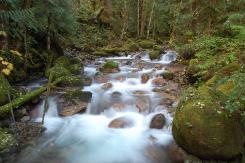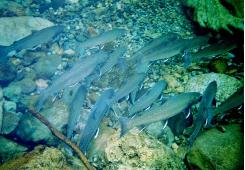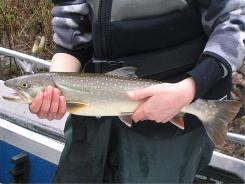Skagit Hydroelectric Project: Endangered Fish Species Recovery Implementation Program

Boulder Creek, a tributary to the Cascade River in the Skagit watershed, will be permanently protected by Seattle City Light’s purchase of the 1,080 acre Boulder Creek watershed.
Summary
The Skagit River supports some of Washington’s most important and valuable fish resources, including habitats for Puget Sound Chinook, bull trout, and steelhead, all species listed under the Endangered Species Act (ESA). Protecting these species requires an in-depth understanding of their life-cycles and the environmental factors affecting their survival, so partners from both the public and private sectors are working together on efforts to learn more and identify effective recovery and protection plans.
Through a multi-faceted collaborative effort Seattle City Light, the Skagit Watershed Council, three Skagit tribes, the Nature Conservancy, and other stakeholders are developing and implementing recovery plans, completing research to guide recovery actions, acquiring and restoring critical freshwater and estuarine habitats, and building support for multi-species fish recovery in the Skagit River watershed. The partners believe this effort will foster relationships among state-resource agencies, tribes, and non-governmental conservation organizations capable of looking beyond traditional regulatory boundaries for the benefit of these species.

Seattle City Light and the Washington Dept. of Fish and Wildlife are partnering on a comprehensive monitoring study on the distribution and population trends of bull trout in the Skagit River.
Background
With an area of 3,200 square miles, the Skagit River is the largest watershed in the Puget Sound region. The river supports the largest wild population of Chinook salmon in the Puget Sound, with about 60 percent of wild Chinook in this region spawning in the 25-mile reach downstream of Seattle City Light’s Skagit Hydroelectric Project. The Skagit River also has the largest population of bull trout in Western Washington, with the 25-mile reach below the project providing important foraging and migration habitat for this species. The river also supports one of the largest wild steelhead runs in Western Washington.
Following the 1999 listing of bull trout and Puget Sound Chinook salmon as threatened under the Endangered Species Act, the City of Seattle implemented the ESA Early Action Program (EAP) to provide funding and support for recovery projects targeting these species in the Skagit River watershed. This voluntary program focuses on projects that protect and restore key habitats limiting Chinook salmon and bull trout populations, as identified through best available science. In 2007, steelhead trout were also listed as a threatened species in the Puget Sound, adding another species to the focus of the EAP.
Seattle City Light has sponsored a wide variety of research, restoration, and land acquisition projects in the headwater, mainstem, estuary, and nearshore areas of the Skagit. Through the end of 2007, Seattle City Light provided over $2.3 million in direct funding for habitat and restoration projects in Skagit watershed. This program has attracted an additional $4.8 million in grants and state and federal matching funds for salmon recovery projects in the Skagit watershed.

Seattle City Light partnered with the University of Washington to study the diet and migratory patterns of bull trout in the Skagit River.
Challenge
Because the Skagit River supports the most important populations of Chinook salmon, bull trout, and steelhead in the Puget Sound, successful implementation of recovery efforts in the Skagit watershed will be critical to the recovery of these ESA-listed species on a region-wide basis. However, recovery can only be accomplished by understanding the life histories of these species and the environmental factors that limit survival at different life stages and by developing and implementing recovery actions that will both protect and restore the habitats that these fish need. For Seattle City Light, this means expanding our efforts and actions well beyond the 25-mile reach of the Skagit River immediately below our hydroelectric project. Recovery will require the protection and restoration of habitat in major Skagit sub basins, including the Cascade and Sauk rivers, which support distinct populations of Chinook, steelhead, and bull trout. It will also require the restoration of habitats in the middle and lower Skagit mainstem, which provide migratory and juvenile rearing habitat for bull trout and juvenile steelhead, and in the estuary and nearshore areas of the Skagit, which are critical to the growth and survival for juvenile Chinook and steelhead.

Colleen McShane, Seattle City Light’s Manager of Natural Resources and Environmental Planning, delivers a speech on behalf of Seattle City Light, which won an OSAW Award for implementing an endangered fish recovery program.
Innovation
Seattle City Light worked closely with the 35-member Skagit Watershed Council to develop recovery and implementation action plans for Chinook salmon. Through this collaboration, the partners launched a three-year recovery action plan in 2007 that includes habitat protection and recovery projects to protect and restore the six independent populations of Chinook present in the Skagit. Seattle City Light provided both staff and financial support to the Skagit Watershed Council to strengthen the development and implementation of the three-year plan. To address the recovery needs of bull trout and steelhead, Seattle City Light became a strong proponent for multi-species fish recovery in the Skagit River watershed. Building support for funding and implementing bull trout and steelhead recovery projects has been challenging in the Skagit watershed and in the Puget Sound because of the strong focus on Chinook recovery in this region. In 2007, Seattle City Light took the lead role in supporting research, land acquisition, and habitat restoration projects targeting bull trout and steelhead in the Skagit watershed. These projects succeeded thanks to the development of long-standing partnerships with federal and state resource agencies, tribes, and non-governmental organizations.
Results
Seattle City Light’s approach towards multi-species ESA fish recovery involves three key components: 1) developing and implementing watershed-wide research programs that improve the scientific understanding of the life history and habitat requirements of listed species; 2) protecting the highest quality habitats remaining that are vital to existing fish populations in the watershed; and 3) restoring habitat conditions in areas throughout the watershed that are limiting the survival and spatial distribution of listed fish species. Working closely with federal and state resource agencies, tribes, and non-governmental conservation organizations, Seattle City Light accomplished major successes in all three areas of this integrated recovery approach in 2007.
Stakeholder Quotes
Regarding Seattle City Light’s purchase of the Boulder Creek Property:
“Seattle City Light’s (SCL) purchase of 1080 acres in the Boulder Creek drainage is the most significant land protection action undertaken in the Upper Skagit River basin within the last five years. Purchase of Boulder Creek not only affords protection to listed species, like bull trout. It further ensures continuation of high water quality inputs to the Cascade River, which directly benefits the Cascade River’s spring Chinook run — another federally listed species. In addition to preserving these fish species, the purchase also protects potential nesting and dispersal habitat for marbled murrelets and spotted owls, respectively, both of which have been documented from adjacent lands.
“Of special importance to more wide-ranging species like the wolf, grizzly bear, wolverine, and other carnivores is the reconnection of two large tracts of mature/old growth forest, managed by the Department of Natural Resources, that were separated by the privately held Boulder Creek ownership. With SCL’s purchase a 3 mile wide swath incorporating portions of the Boulder and Inez Creek drainages are now under public ownership and management.
“The utility, which is the leader within the energy industry in wildlife habitat protection, and the previous landowner are to be commended for the perseverance they exhibited during their 2.5 year long negotiations. The resulting purchase is a distinct public benefit. It is also exemplary of the excellent work SCL has done to protect wildlife in the Skagit Basin since signing the Negotiated Settlement of 1991, which relicensed the hydropower dams on the Skagit River.” — Fayette Krause, Senior Conservation Advisor, The Nature Conservancy
Regarding Seattle City Light’s implementation of the “Skagit Chinook, Steelhead and Bull Trout Yearling Studies”:
“The yearling studies [sponsored by SCL] provide much needed ecological data about federally listed bull trout, steelhead and Chinook that are critical to the effectiveness of future restoration and recovery actions and planning occurring throughout one of the most significant watersheds in the state of Washington.” — Eric Beamer, Research Director, Swinomish & Sauk-Suiattle Tribes as represented by the Skagit River System Cooperative


